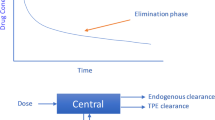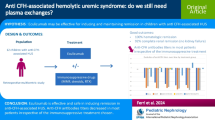Abstract
We investigated the occurrence of hepatic veno-occlusive disease (VOD) after allogeneic bone marrow transplantation (BMT) in 241 adults conditioned with busulfan + cyclophosphamide at a single institute and retrospectively compared 186 patients who received oral busulfan (O-Bu group) with 55 patients who received intravenous busulfan (I-Bu group). Various hemostatic parameters were determined at baseline and on days 0, 7, 14, and 21. Hepatic VOD occurred in 41.7% of the O-Bu group and in 18.5% of the I-Bu group. Multivariate analysis revealed that the I-Bu group had significantly decreased risk of VOD compared to the O-Bu group [p=0.006, odds ratio: (OR) 0.345]. Eleven patients in the O-Bu group and none of the I-Bu group developed severe VOD. A repeated measures analysis of variance (ANOVA) with a between-subjects factor revealed significant differences in post-transplant levels of antithrombin III, tissue plasminogen activator (tPA), plasminogen activator inhibitor 1 (PAI-1), and D-dimer according to the occurrence of VOD. The level of antithrombin III was significantly lower, whereas the level of D-dimer was significantly higher, in the O-Bu group than in the I-Bu group. These findings show that, in adults conditioned with busulfan + cyclophosphamide, intravenous busulfan was associated with significantly decreased incidence of VOD and fewer hemostatic derangements after allogeneic BMT compared to oral busulfan.
Similar content being viewed by others
References
Bearman SI (1995) The syndrome of hepatic veno-occlusive disease after marrow transplantation. Blood 85:3005–3020
Baglin TP (1994) Veno-occlusive disease of the liver complicating bone marrow transplantation. Bone Marrow Transplant 13:1–4
Strasser SI, McDonald GB (2004) Gastrointestinal and hepatic complications. In: Blume KG, Forman SJ, Appelbaum FR (eds) Thomas’ hematopoietic cell transplantation. Blackwell, Malden, MA, pp 769–810
Lee JH, Lee KH, Kim S, Lee JS, Kim WK, Park CJ, Chi HS, Kim SH (1998) Relevance of proteins C and S, antithrombin III, von Willebrand factor, and factor VIII for the development of hepatic veno-occlusive disease in patients undergoing allogeneic bone marrow transplantation: a prospective study. Bone Marrow Transplant 22:883–888
Tanikawa S, Mori S, Ohhashi K, Akiyama H, Sasaki T, Kaku H, Hiruma K, Matsunaga T, Morita T, Sakamaki H (2000) Predictive markers for hepatic veno-occlusive disease after hematopoietic stem cell transplantation in adults: a prospective single center study. Bone Marrow Transplant 26:881–886
Faioni EM, Krachmalnicoff A, Bearman SI, Federici AB, Decarli A, Gianni AM, McDonald GB, Mannucci PM (1993) Naturally occurring anticoagulants and bone marrow transplantation: plasma protein C predicts the development of venocclusive disease of the liver. Blood 81:3458–3462
Scrobohaci ML, Drouet L, Monem-Mansi A, Devergie A, Baudin B, D’Agay MF, Gluckman E (1991) Liver veno-occlusive disease after bone marrow transplantation changes in coagulation parameters and endothelial markers. Thromb Res 63:509–519
Lee JH, Lee KH, Choi SJ, Min YJ, Kim JG, Kim S, Lee JS, Kim SH, Park CJ, Chi HS, Kim WK (2000) Veno-occlusive disease of the liver after allogeneic bone marrow transplantation for severe aplastic anemia. Bone Marrow Transplant 26:657–662
Lee JH, Lee KH, Lee JH, Kim S, Seol M, Park CJ, Chi HS, Kang W, Kim ST, Kim WK, Lee JS (2002) Plasminogen activator inhibitor-1 is an independent diagnostic marker as well as severity predictor of hepatic veno-occlusive disease after allogeneic bone marrow transplantation in adults conditioned with busulphan and cyclophosphamide. Br J Haematol 118:1087–1094
Salat C, Holler E, Kolb HJ, Reinhardt B, Pihusch R, Wilmanns W, Hiller E (1997) Plasminogen activator inhibitor-1 confirms the diagnosis of hepatic veno-occlusive disease in patients with hyperbilirubinemia after bone marrow transplantation. Blood 89:2184–2188
Salat C, Holler E, Kolb HJ, Pihusch R, Reinhardt B, Penovici M, Ledderose G, Hiller E (1999) The relevance of plasminogen activator inhibitor 1 (PAI-1) as a marker for the diagnosis of hepatic veno-occlusive disease in patients after bone marrow transplantation. Leuk Lymphoma 33:25–32
McDonald GB, Hinds MS, Fisher LD, Schoch HG, Wolford JL, Banaji M, Hardin BJ, Shulman HM, Clift RA (1993) Veno-occlusive disease of the liver and multiorgan failure after bone marrow transplantation: a cohort study of 355 patients. Ann Intern Med 118:255–267
Yeager AM, Wagner JE Jr, Graham ML, Jones RJ, Santos GW, Grochow LB (1992) Optimization of busulfan dosage in children undergoing bone marrow transplantation: a pharmacokinetic study of dose escalation. Blood 80:2425–2428
Dix SP, Wingard JR, Mullins RE, Jerkunica I, Davidson TG, Gilmore CE, York RC, Lin LS, Devine SM, Geller RB, Heffner LT, Hillyer CD, Holland HK, Winton EF, Saral R (1996) Association of busulfan area under the curve with veno-occlusive disease following BMT. Bone Marrow Transplant 17:225–230
Vassal G, Deroussent A, Challine D, Hartmann O, Koscielny S, Valteau-Couanet D, Lemerle J, Gouyette A (1992) Is 600 mg/m2 the appropriate dosage of busulfan in children undergoing bone marrow transplantation? Blood 79:2475–2479
Slattery JT, Clift RA, Buckner CD, Radich J, Storer B, Bensinger WI, Soll E, Anasetti C, Bowden R, Bryant E, Chauncey T, Deeg HJ, Doney KC, Flowers M, Gooley T, Hansen JA, Martin PJ, McDonald GB, Nash R, Petersdorf EW, Sanders JE, Schoch G, Stewart P, Storb R, Sullivan KM, Thomas ED, Witherspoon RP, Appelbaum FR (1997) Marrow transplantation for chronic myeloid leukemia: the influence of plasma busulfan levels on the outcome of transplantation. Blood 89:3055–3060
Shaw PJ, Scharping CE, Brian RJ, Earl JW (1994) Busulfan pharmacokinetics using a single daily high-dose regimen in children with acute leukemia. Blood 84:2357–2362
DeLeve LD, Wang X (2000) Role of oxidative stress and glutathione in busulfan toxicity in cultured murine hepatocytes. Pharmacology 60:143–154
Slattery JT, Kalhorn TF, McDonald GB, Lambert K, Buckner CD, Bensinger WI, Anasetti C, Appelbaum FR (1996) Conditioning regimen-dependent disposition of cyclophosphamide and hydroxycyclophosphamide in human marrow transplantation patients. J Clin Oncol 14:1484–1494
Hassan M, Ljungman P, Ringden O, Hassan Z, Oberg G, Nilsson C, Bekassy A, Bielenstein M, Abdel-Rehim M, Georen S, Astner L (2000) The effect of busulphan on the pharmacokinetics of cyclophosphamide and its 4-hydroxy metabolite: time interval influence on therapeutic efficacy and therapy-related toxicity. J Clin Oncol 25:915–924
Grochow LB, Jones RJ, Brundrett RB, Braine HG, Chen TL, Saral R, Santos GW, Colvin OM (1989) Pharmacokinetics of busulfan: correlation with veno-occlusive disease in patients undergoing bone marrow transplantation. Cancer Chemother Pharmacol 25:55–61
Grochow LB (1993) Busulfan disposition: the role of therapeutic monitoring in bone marrow transplantation induction regimens. Semin Oncol 20:18–25
Fernandez HF, Tran HT, Albrecht F, Lennon S, Caldera H, Goodman MS (2002) Evaluation of safety and pharmacokinetics of administering intravenous busulfan in a twice-daily or daily schedule to patients with advanced hematologic malignant disease undergoing stem cell transplantation. Biol Blood Marrow Transplant 8:486–492
Andersson BS, Kashyap A, Gian V, Wingard JR, Fernandez H, Cagnoni PJ, Jones RB, Tarantolo S, Hu WW, Blume KG, Forman SJ, Champlin RE (2002) Conditioning therapy with intravenous busulfan and cyclophosphamide (IV BuCy2) for hematologic malignancies prior to allogeneic stem cell transplantation: a phase II study. Biol Blood Marrow Transplant 8:145–154
Kashyap A, Wingard J, Cagnoni P, Roy J, Tarantolo S, Hu W, Blume K, Niland J, Palmer JM, Vaughan W, Fernandez H, Champlin R, Forman S, Andersson BS (2002) Intravenous versus oral busulfan as part of a busulfan/cyclophosphamide preparative regimen for allogeneic hematopoietic stem cell transplantation: decreased incidence of hepatic venoocclusive disease (HVOD), HVOD-related mortality, and overall 100-day mortality. Biol Blood Marrow Transplant 8:493–500
Hassan M, Ehrsson H, Ljungman P (1996) Aspects concerning busulfan pharmacokinetics and bioavailability. Leuk Lymphoma 22:395–407
Bornhauser M, Storer B, Slattery JT, Appelbaum FR, Deeg HJ, Hansen J, Martin PJ, McDonald GB, Nichols WG, Radich J, Woolfrey A, Jenke A, Schleyer E, Thiede C, Ehninger G, Anasetti C (2003) Conditioning with fludarabine and targeted busulfan for transplantation of allogeneic hematopoietic stem cells. Blood 102:820–826
Andersson BS, Madden T, Tran HT, Hu WW, Blume KG, Chow DS, Champlin RE, Vaughan WP (2000) Acute safety and pharmacokinetics of intravenous busulfan when used with oral busulfan and cyclophosphamide as pretransplantation conditioning therapy: a phase I study. Biol Blood Marrow Transplant 6:548–554
Lee JH, Lee KH, Choi JS, Zang DY, Kim SB, Kim SW, Suh C, Lee JS, Kim WK, Lee YS, Kim SH (1996) Veno-occlusive disease (VOD) of the liver in Korean patients following allogeneic bone marrow transplantation (BMT): efficacy of recombinant human tissue plasminogen activator (rt-PA) treatment. J Korean Med Sci 11:118–126
Bensinger W, Spielberger R (2004) Preparative regimens and modification of regimen-related toxicities. In: Blume KG, Forman SJ, Appelbaum F (eds) Thomas’ hematopoietic cell transplantation. Blackwell, Malden, MA, pp 158–177
Shulman HM, Gown AM, Nugent DJ (1987) Hepatic veno-occlusive disease after bone marrow transplantation. Immunohistochemical identification of the material within occluded central venules. Am J Pathol 127:549–558
Fajardo LF, Colby TV (1980) Pathogenesis of veno-occlusive liver disease after radiation. Arch Pathol Lab Med 104:584–588
DeLeve LD, McCuskey RS, Wang X, Hu L, McCuskey MK, Epstein RB, Kanel GC (1999) Characterization of a reproducible rat model of hepatic veno-occlusive disease. Hepatology 29:1779–1791
Brooks SE, Miller CG, McKenzie K, Audretsch JJ, Bras G (1970) Acute veno-occlusive disease of the liver. Fine structure in Jamaican children. Arch Pathol 89:507–520
Coppell JA, Brown SA, Perry DJ (2003) Veno-occlusive disease: cytokines, genetics, and haemostasis. Blood Rev 17:63–70
Brown SA, Davies SV, Fegan C, West R, Giddings J, Whittaker J, Burnett AK (1999) Haemostatic and fibrinolytic responses to bone marrow transplantation. Br J Haematol 104:468–474
Wells PS, Anderson DR, Rodger M, Forgie M, Kearon C, Dreyer J, Kovacs G, Mitchell M, Lewandowski B, Kovacs MJ (2003) Evaluation of D-dimer in the diagnosis of suspected deep-vein thrombosis. N Engl J Med 349:1227–1235
Sudhoff T, Heins M, Sohngen D, Lenz V, Wehmeier A, Aul C, Meckenstock G, Schneider W, Reinauer H, Heyll A (1998) Plasma levels of D-dimer and circulating endothelial adhesion molecules in veno-occlusive disease of the liver following allogeneic bone marrow transplantation. Eur J Haematol 60:106–111
Jansson JH, Olofsson BO, Nilsson TK (1993) Predictive value of tissue plasminogen activator mass concentration on long-term mortality in patients with coronary artery disease. A 7-year follow-up. Circulation 88:2030–2034
Asakura H, Ontachi Y, Mizutani T, Kato M, Saito M, Kumabashiri I, Morishita E, Yamazaki M, Aoshima K, Nakao S (2001) An enhanced fibrinolysis prevents the development of multiple organ failure in disseminated intravascular coagulation in spite of much activation of blood coagulation. Crit Care Med 29:1164–1168
Ridker PM, Hennekens CH, Stampfer MJ, Manson JE, Vaughan DE (1994) Prospective study of endogenous tissue plasminogen activator and risk of stroke. Lancet 343:940–943
Richardson PG, Murakami C, Jin Z, Warren D, Momtaz P, Hoppensteadt D, Elias AD, Antin JH, Soiffer R, Spitzer T, Avigan D, Bearman SI, Martin PL, Kurtzberg J, Vredenburgh J, Chen AR, Arai S, Vogelsang G, McDonald GB, Guinan EC (2002) Multi-institutional use of defibrotide in 88 patients after stem cell transplantation with severe veno-occlusive disease and multisystem organ failure: response without significant toxicity in a high-risk population and factors predictive of outcome. Blood 100:4337–4343
Pratt DS, Kaplan MM (2001) Evaluation of liver function. In: Braunwald E, Fauci AS, Kasper DL, Hauser SL, Longo DL, Jameson JL (eds) Harrison’s principles of internal medicine. McGraw-Hill, New York, pp 1711–1715
Author information
Authors and Affiliations
Corresponding author
Rights and permissions
About this article
Cite this article
Lee, JH., Choi, SJ., Lee, JH. et al. Decreased incidence of hepatic veno-occlusive disease and fewer hemostatic derangements associated with intravenous busulfan vs oral busulfan in adults conditioned with busulfan + cyclophosphamide for allogeneic bone marrow transplantation. Ann Hematol 84, 321–330 (2005). https://doi.org/10.1007/s00277-004-0982-4
Received:
Accepted:
Published:
Issue Date:
DOI: https://doi.org/10.1007/s00277-004-0982-4




